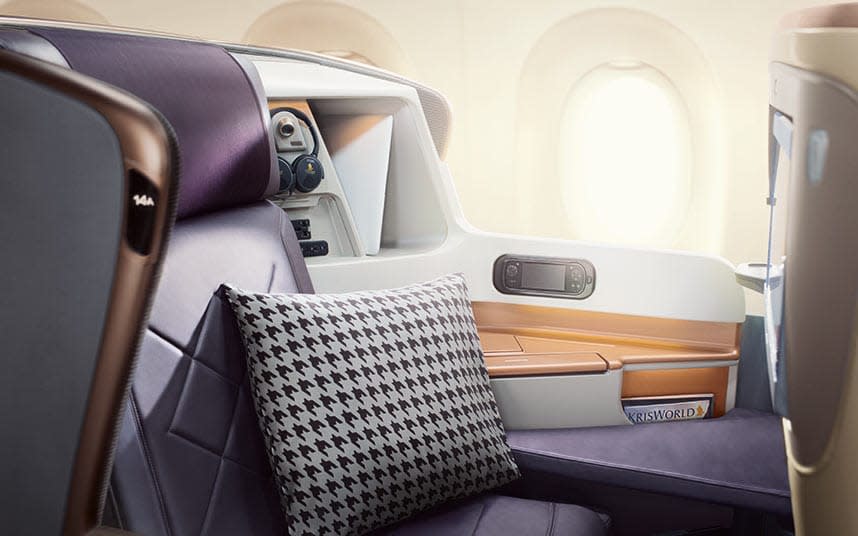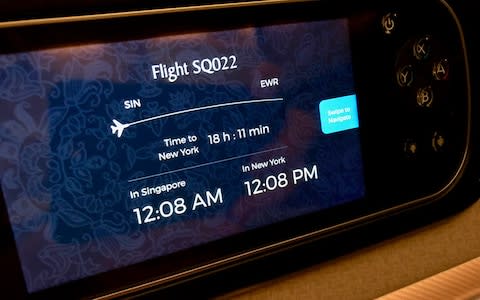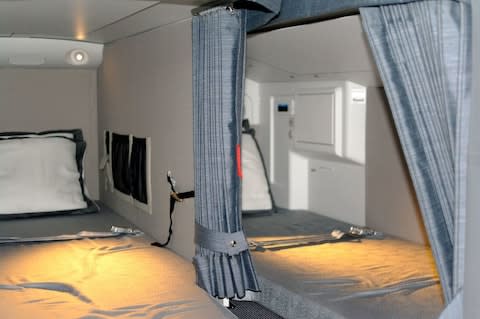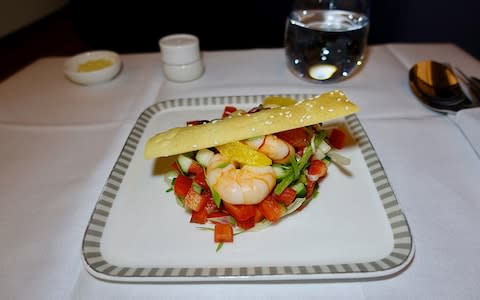What it's really like on board the world's longest flight

“Are we there yet?” It’s a predictably cheeky remark to make shortly after take-off as I set out on the world’s longest flight, a marathon 16,700km (9,537 miles) non-stop trek between Singapore and New York, on flight number SQ22.
But the inflight screen is not amused, its flight map pointing out that there are just over 18 hours to go.
Besides, this is not a journey to be taken lightly. How do you spend almost a day sitting in a glorified tin can? And more importantly, what shape will I be in when I reach The Big Apple?
The answer to the second question lies literally half a world away. As to passing those arduous hours that stretch ahead, I could watch two seasons of Game of Thrones or all eight Harry Potter films. I could listen to every song ever recorded by The Beatles, twice over. Being less ambitious, I settle for a handful of blockbusters and a lot of sleeping.
Both are easily done. Singapore Airlines has loaded up the aircraft with 1,200 hours of movies and TV shows, and my business class seats folds out into a long fully-flat bed topped with a soft mattress.

The cabin of the Airbus A350 has a curious layout that means passengers sleep at what feels like a 45 degree diagonal rather than facing straight ahead, which takes some getting used to – I find that sleeping on my side rather than my back makes the skew less noticeable. But there’s only so much sleeping you can do, and so my mind turns to sustenance.
In addition to its standard menu, Singapore Airlines has enlisted US nutritional firm Canyon Ranch to craft a selection of ‘wellness’ meals to sit lightly on the stomach yet contain the right combination of proteins and carbohydrates to keep passengers fuelled up. It’s a similar approach to that taken by Qantas for its own 17-hour flights between Perth and London.
Despite my dislike of the ‘wellness’ buzzword I opt for the Canyon Ranch menu, which includes a Greek yoghurt with granola and a delightful prawn ceviche. However, before long I am eyeing up with envy my seatmate’s lobster thermidor.
About four hours into the flight, Captain SL Leong, Singapore Airlines’ chief pilot for the Airbus A350 jets, and was ‘behind the stick’ for take-off, takes his first break. He heads to a dedicated rest area for flight deck crew, where a secluded suite with actual beds (not seats which convert to a bed) sits behind a security-coded door.

Leong will spend between four and five hours in his bunk, then start a second shift for another four or five hours, and continue that routine until we land.
The 13-strong cabin crew follow the same schedule – four hours on, four hours off – with their own communal bunks at the rear of the plane, located up a narrow flight of stairs in a hidden loft above the last four rows of seats. These cubicles are the crew's off-duty haven and there’s a surprising amount of space.
Meanwhile, I make a cosy nest of my stylish and comfortable pod, which has plenty of compartments and nooks to keep items close at hand rather than stow into the overhead bins. One of those items includes my own amenity kit, as Singapore Airlines’ offering is decidedly mediocre and lacks even the basics of a moisturiser. I recommend that all travellers put together a DIY bag with their choice of essentials: mine has been cobbled together from other airlines and includes a broader assortment of skincare products, eye drops, an eye mask and aromatherapy sleep spray, plus some Berocca for a fizzy hit of Vitamin B. I’ve also packed my own pyjamas, because unlike several others premium airlines, Singapore Airlines doesn’t hand out PJs in business class.
It’s high time to stretch my legs, so I go for a stroll through the aisles, from tip to tail, for a quick tour of this new aircraft. And it’s very new: this jet has only just been delivered from Airbus’ factory in Toulouse, France.
It still has that new plane smell, which is just like new car smell, only much more expensive: Airbus lists the A350’s price at around $445 million (£338m), although airlines are said to enjoy a discount of least 40 per cent off the sticker.

Though this is a special ultra-long range version of the jetliner, capable of carrying extra fuel and with some clever aerodynamic design tweaks to extend its flying distance from the standard 15 hours, Singapore Airlines still had to reduce the number of passengers to make this bird go the distance, so this A350 carries just 161 seats – 67 in business class and 94 in premium economy. There are no economy seats in this unique ‘all-premium’ layout, and I think anybody who has flown economy for more than 12 hours will be grateful.
And while this non-stop flight is a magnet for the busy business traveller, plenty of holidaymakers will join them.
“There’s always a good proportion of leisure travellers in business class and certainly premium economy, and that’s increasingly the case today,” says Singapore Airlines senior vice president Campbell Wilson. “There’s increasing affluence, especially among 30-somethings are quite happy to spend n travel and treating themselves. With longer lifespans we see people being more active after retirement, and some certainly can afford and want that additional comfort.”
Like its arch-rival, the popular Boeing 787 Dreamliner, Airbus designed this new jet with a lower cabin altitude – equivalent to 6,000 feet above sea level, compared to 8,000 feet in older aircraft. This alleviates many side-effects of air travel such as muscle fatigue and even dull headaches.

The cabin is also more humid, in a good way. A fuselage woven from advanced carbon-fibre composite materials instead of aluminium allows the A350 to pump more water into the air to keep your skin from drying out, although a good slathering of moisturiser is still highly recommended.
There’s more fresh air pumped through the cabin, too, and what’s already circulating is run through high-efficiency filters to reduce odour and trap germs and contaminants.
But as this flight skips across 13 timezones, my bodyclock has become as effective as a knackered watch from a fleamarket.
Conventional tricks of the savvy traveller, such as adopting the time zone of destination as soon as your flight takes off, make little sense when your midnight departure from Singapore is noon in New York. I therefore decide to declare my own personal timezone and go with the flow.
Halfway through the flight, a main meal is served – time for more wellness food, although I weaken and add some satay sticks and a Singapore Sling.
About two-thirds of the way through the flight, however, I’m keen to be on terra firma. Aches in my lower back and legs can be alleviated only by leaving the seat for a walk and a stretch, but there’s nowhere else to go. Even the exit areas are between busy kitchen galleys. I become convinced that any aircraft doing these ultra-long flights really needs a lounge area or at least a stand-up bar so you can escape your luxurious cocoon and enjoy a change of scenery.
As the clock ticks towards 5am New York time, Captain Leong announces our imminent touchdown and instructs “cabin crew, please prepare for arrival”. I’m not sure this scripted line has ever sounded so welcome.
I certainly don’t go skipping off the flight, although I’m feeling much better than expected. And I’d readily do the flight again, because travelling from Singapore to New York in one long stretch is better than the layover alternatives.
That said, airlines pushing the boundaries of non-stop flights are also finding the boundaries of what the human body can comfortably tolerate, and I feel more work is needed in that area. It might even tilt the balance of innovation towards the next generation of supersonic jets, for those high flyers who can afford the faster-than-sound premium.
David Flynn is the editor of Australian Business Traveller.